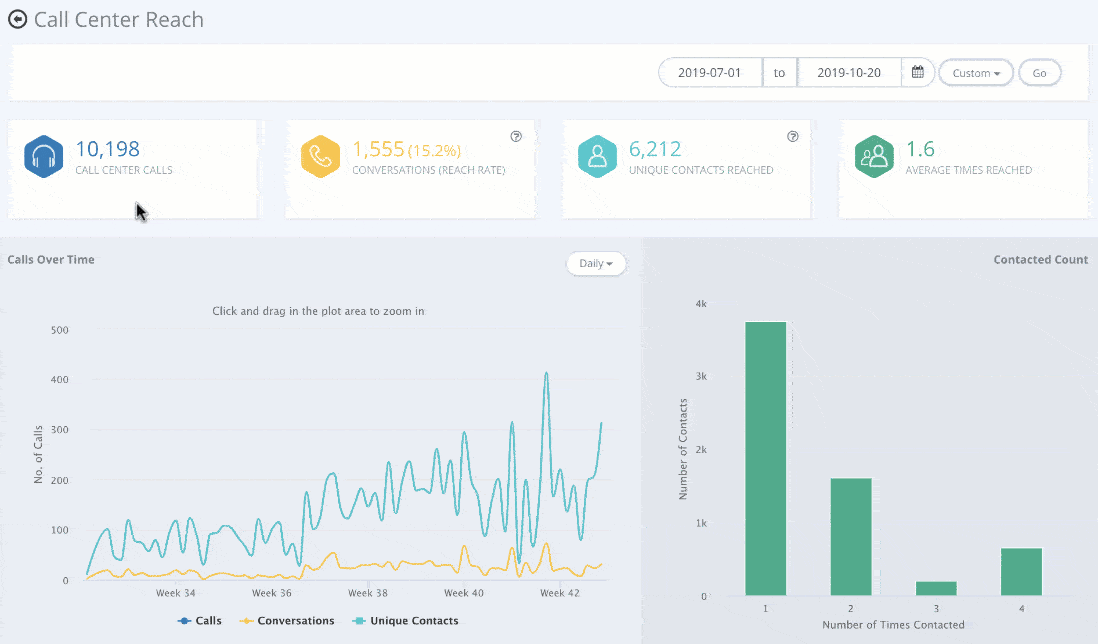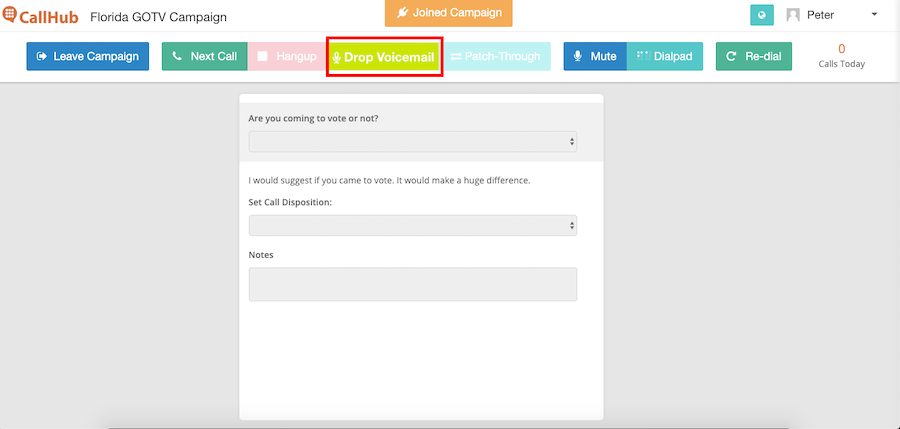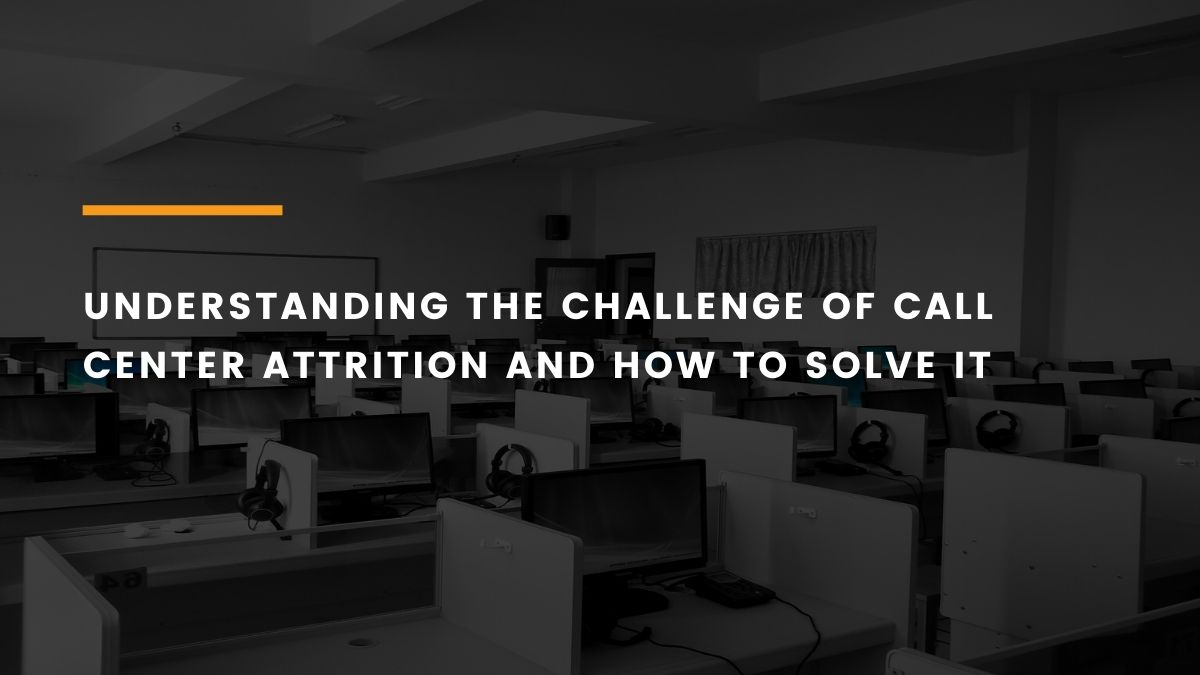Table of Contents
The cost of replacing a call center employee is about 20% of their annual salary.
By that calculation, employee turnover for a company with 50 people and attrition of 30% (the minimum of the industry average) can cost $100,000 a year.
This cost doesn’t take into account other soft costs like productivity, employee ROI, etc. into account.
These costs are just one of the many side effects of high call center attrition. If left unchecked, this can significantly affect your business’ health.
If you don’t want that happening to your organization, this is the guide to help you deal with attrition.
What is call center attrition?
Call center attrition is the rate at which employees leave the workforce over a given period. The term is also referred to as employee churn.
Industry surveys concluded that the average call center attrition rate ranges from 30-45%.
Call center attrition varies with a lot of other factors like:
- Location (area/country)
- Nature of call center
- Hierarchy level
- Employee age groups etc.
But, these factors do not have a direct effect on it. Instead, they amplify the reasons for attrition (which we will talk about later).
For example, outbound telemarketing companies have a higher churn because employee burnout is more severe in call centers of this nature. On the other hand, inbound call centers have lower attrition.
Nevertheless, like most benchmark figures, the attrition of others in the industry shouldn’t be your point of focus. What’s important is the employee churn in your organization, the reasons for it, and what you can do about it.
How do you calculate call center attrition?
Calculating this metric is relatively simple. It’s calculated over a given period, typically a year. The formula is as follows:

You can get a more holistic picture by taking into account other nuances of the metric.
How to calculate new employee attrition rate
Employees who leave within one year of joining cost a lot. Companies spend on their training and don’t see equal returns during this time. It takes up to 1-2 years for an employee to become fully productive, as per studies.
Hence, it’s critical to ensure that your new employee attrition rate is as low as possible. Here’s the formula for it:

How to calculate voluntary and involuntary attrition rate
Voluntary attrition is when agents leave of their own accord. New career opportunities, personal issues, etc. are a few reasons for this type of churn.
The formula is similar to that of the original attrition rate:

When the company asks an employee to leave, it is known as involuntary attrition. Downsizing, skill redundancy, performance issues, etc. are some common reasons behind involuntary attrition.

Companies may argue that since involuntary churn is planned for, it should not be included in attrition calculations. However, experts disagree with this notion.
“I’ve worked in contact centers where management has told me ‘it’s involuntary, so it’s fine,’ and we’ve chosen for those people to leave. But I don’t think it’s fine because it is a cost to the business, and it’s indicative of there being a problem somewhere.”
- Dougie Cameron, Director, and Founder, Addzest Consulting
These nuances help you identify the segments in which attrition is the highest. Understanding these segments helps you identify the exact reasons for churn as we’ll see in the next section.
Major reasons for call center attrition and how to reduce it
The first step to fixing call center attrition is identifying the problem. In the industry, the primary contributing factors are:
Lack of training
It may seem tempting to put recruits to work immediately and get them to start being productive. However, this is a recipe for disaster. Not training recruits to deal with high-stress situations leads to frustration and poor performance. Ultimately, these factors drive them to leave.
A study by SHRM stated that a good training program helps companies retain 91% of their first-year workers.
Training is also the first experience of your company culture that new hires receive. Rushing through it may give a poor impression and lead them to look for better workplaces actively.
How to identify this reason for attrition
Lack of training typically affects new employees the most. It does have some impact on existing ones too. However, chances are they might have learned to deal with it better.
Therefore, if you see a rise in new employee attrition, you can be fairly certain that it’s your lackluster training.
Solution: Use the right training program.
Your training program should make agents feel more competent. They will stay longer in a company they do well in.
To make your training program more impactful, it should be:
- Engaging: Keep your employees hooked with role-plays and use videos to keep it fun.
- Customized to each agent: Everyone has different strengths and weaknesses that you address. You can break down larger teams based on similar characteristics, and work on each group.
- Practical: Instead of narrating theory, have your top performers breakdown some great calls and give actionable insights. This will also help make current employees feel more valued and engaged.
- Holistic: Training should not be limited to soft skills but include software training too. Recruits need to be well-versed with the platform they will be using to be more productive.
Employee burnout
Employee burnout is quite a common occurrence in call centers. Typically, burnout strikes when employees have exhausted their physical or emotional strength. Lack of engagement or support, unreasonable time pressure, and employee’s expectations of themselves are the usual causes.
According to research, HR leaders say employee burnout is responsible for 20% to 50% of annual turnover.
If an employee reaches a point of burnout, you first see a dip in their performance. This, in turn, leads to them feeling demotivated and finally leaving, either voluntarily or involuntarily, due to poor performance.
How to identify this reason for attrition
Employee burnout affects those who have been in the organization longer. New employees may be safe from it, at least for a while.
Hence, if there is an increase in voluntary and involuntary attrition, but new employee churn remains almost constant, you can attribute it to burnout.
Solution: Keep the workplace engaging with healthy competition
Competition inspires people to put in more effort and get creative to achieve results. It also keeps the workplace fun and a little relaxed.
However, there is a fine line between healthy and unhealthy competition that needs to be maintained. To ensure that that, you need to:
- Promote a team-first mentality: Have employees compete as groups rather than individuals. Set rules to encourage them to work together and win as a team. This also improves relationships among employees.
- Provide flexibility for creativity: Restrictions could make competitions unfair since everyone has different strengths. Let employees play their strengths and creativity to level the field.
- Reward everyone: It’s unusual, but remember that everyone did put in the effort. Appreciate everyone to avoid feelings of conflict between teams. You can have different levels of incentives to maintain a competitive spirit.
When running competitions, it can be challenging to keep track of everyone’s performance. In that case, you can use a call center software with such a feature. CallHub’s agent and team leaderboard features let you do that.

Limited opportunities for advancement
Employees who stay in an organization for long usually make the most significant difference. The only thing that motivates people to stick to a company is personal development.
According to an SHRM study, 60% of a company’s entire workforce leaves within four years if there is no formal process for career development.
Often, call centers don’t have a formal structure for advancement, especially from mid-level to higher-level positions. This can be discouraging, especially to the top performers.
How to identify this reason for attrition
When your voluntary attrition rate goes up, chances are this is the reason. If you notice a trend of top performers leaving, you can be sure of it.
The top performers in a company are the ones most driven to advance in their careers. However, if they don’t have ample opportunities available, they will be quick to leave.
Solution: Establish a clear career path
The details you put down must indicate everything required for the agent to move forward. These include performance KPIs, how extra opportunities affect it, the appraisal process, etc.
While mapping out these opportunities, make sure to:
- Document everything: Have comprehensive documentation that everybody can access. It also allows agents to refer to it and analyze and realign their efforts.
- Have a feedback process: Team leaders should have regular feedback sessions regarding these opportunities with employees. Highlight how they are doing and what they need to do to increase their chances of promotion. This promotes good company culture too.
Substandard tools
The lack of tools does not directly impact call center attrition. However, it does lead to other unwanted situations that do.
For example, if agents use a manual dialer, they waste a lot of productive time dialing numbers, which may or may not connect. As a result, agents make fewer calls and conversions and perform poorly. On the other hand, using automated dialers would eliminate this issue and enhance employee productivity.
In a survey by G2, 52% of respondents said they were dissatisfied in their roles due to mismatched software. Moreover, 24% said they considered looking for a new job due to unsuitable software.
How to identify this reason for attrition
Technology mismatch is a serious problem that affects all call center employees.
When your overall attrition rate goes up, you will have to assume that this could be one of the reasons. Employee exit interviews (which we’ll cover later) can give you more insights.
Solution: Use updated technology to support employees.
In a survey by G2, 96% of respondents said they would be more satisfied at work with access to better software. Another 62% stated that software mismatch is stopping them from reaching their full potential.
This shows that the right technology doesn’t just boost job satisfaction but also productivity. For call centers, the perfect software is one that has the following primary features:
- Multiple dialer options – Manually dialing numbers is a trivial task that wastes productive time. Avoid this by using software with auto-dialing.
However, that’s not enough. The solution must have multiple options to give you the flexibility to manage the calling speed as per your needs. For example, in CallHub you get the option for power dialer, predictive dialer, auto-dialer, and preview dialer.
- Comprehensive analytics dashboard – A dashboard is essential for your team leaders to keep track of performance. Ensure that your tool doesn’t just provide overall campaign metrics but also tracks individual agent activity.

- Voicemail drop – Leaving a voicemail is another trivial task that can be skipped with a solution that allows you to leave pre-recorded messages.

More advanced solutions have automated answering machine detection that leaves messages automatically. This is more time-efficient and allows agents to focus on live calls.
- Remote working ability: When selecting a call center software, it’s recommended to use one that lets you set up a virtual call center and enables agents to work remotely. It can help you save up to $25,000 per employee. Plus, such flexibility is also appealing to younger generations and can boost your recruitment campaigns.
Inefficient leadership
An employee’s quality of work-life depends heavily on their relationship with the leadership.
Agents are driven to leave if they don’t get any support or motivation from their managers. Moreover, the biased opinions of team leaders of agents also affect this relationship. This is a serious concern in companies without a formal process to track and assess employee performance.
A Gallup poll concluded that 75% of workers voluntarily left their jobs because of their bosses. This was true even if the position or role was a good one.
How to identify this reason for attrition
Ineffective leadership typically affects all employees equally within a team. Hence you will have to look at the churn within each group.
But remember, attrition within teams may not be as evident in the overall metric. Therefore, ensure that you keep track of this regularly.
To calculate team attrition, just modify the original formula for a team over a period.

Solution: Hold an exit interview
Employees not committed to the organization may be franker with you, as long as you assure them about its confidentiality.
Also, you may get some additional feedback that you can use to make the experience of other employees better.
To get the most out of exit interviews, ensure that:
- The meeting is scheduled well in advance: Schedule the meeting ahead and ask the employee to prepare for it well. Give them time to keep some pointers ready as it might be difficult to recall things on the spot.
- The direct manager is not involved: Even with the best managers, there is room for improvement. But, employees may not be comfortable pointing it out in front of them. Generally, it’s good practice to have only the HR managers take the interview.
- A customized questionnaire is prepared: Navigating the conversation without a plan may not result in any actionable feedback. Take some time to prepare a list of questions specific to the employee and the role. This will give you more practical insights that you can take action on.
To conclude
High call center attrition is a dangerous industry problem. But it doesn’t have to be yours if you take the right steps.
It is said that the simplest way to stop your employees from leaving is to start by developing a plan to make them stay. Hopefully, the tips above help you do that.

